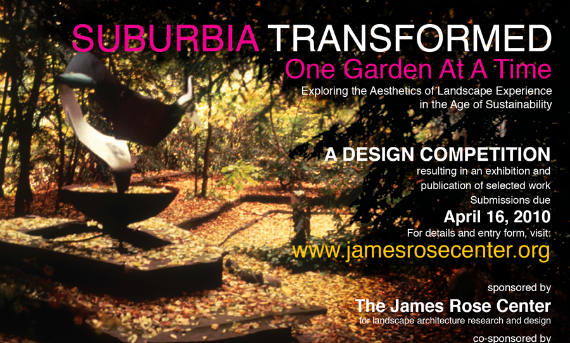With yesterday’s long-delayed opening of Pier 1, the 85-acre Brooklyn Bridge Park is now approximately seven percent complete! OK, so there’s still a long way to go until New York’s third great urban landscape is whole—but, if this first section is any indication, it will be worth the wait. Pier 1 includes waterfront promenades, large lawns, a playground, and the “Granite Prospect,” an impressive riverside staircase made out of more than 300 pieces of salvaged granite.
Screaming Trees
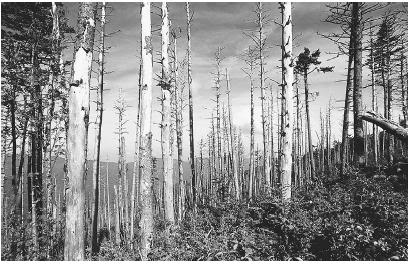
A new post on Yale Environment 360 reports on the large-scale dying off of the world's forests at an extraordinary rate. Much of the death has been attributed by entomologists to the mountain pine beetle, which due to warming winters is enabling their lifecycle to decrease from two to one year, able to produce more larvae in pines of the west. Colder temperatures had once kept the beetle out of higher altitudes, but a slight warming is now bringing devastation to mountaintop forests.
Since 2000, a forest area the size of Washington state has been killed and attributed to insects. But scientists see this as a sympton of an even larger problem of a warming climate. North America has not been the only continent affected, as forests in Australia, Russia, China, and France have been lost to drought, high temperatures, or both. Drought and higher temperatures leave forests ecologies weaker and more susceptable to pests and wildfires.
So the forests across the West are dying, in such large numbers that U.S. Secretary of the Interior Ken Salazar called it the West’s Hurricane Katrina. In Colorado and southern Wyoming, the U.S. Forest Service has created an emergency management team to cut down dead trees around towns and along roads and power lines. Forest Service campgrounds and trails have been closed because of the hazard from dead trees, and communities surrounded by dead forests have drawn up emergency evacuation plans for residents.
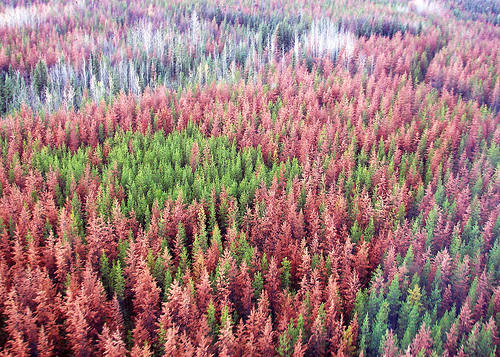 [Dying pine forests, said to be caused by the mountain pine beetle]
[Dying pine forests, said to be caused by the mountain pine beetle]
But what to do? Many of the reasons are still definitively undetermined, and the topic is grossly understudied with large information gaps and uncertainties. The forest deaths are naturally having effects on certain wildlife habits and food sources. But can anykind of human intervention (other then carbon reduction) be done to prevent this widespread forest destruction? As devastating as it may be, perhaps a transition from live to dead forests will manifest into a faster-paced evolution of forest, in which no intervention is necessary. Some species will be lost, while others thrive using the dying material for habitats. Non-native birds will carry non-native seeds more adaptive to the changing climate. New plant material will bring new consumers and predators to these areas.
 [Dead trees aren't a total waste, in fact they contribute vital habitats like for these Acorn Woodpeckers]
[Dead trees aren't a total waste, in fact they contribute vital habitats like for these Acorn Woodpeckers]
It’s not surprising that most of us tend to view dead things as undesirable. We impose this cultural bias about dead things to our forests as well. Public land management agencies spend billions annually trying to contain wildfire and insect outbreaks based upon the presumption that these natural processes are destroying the forest by killing trees. Even though there is now some grudging acceptance by land managers that wildfires and insect attacks may be potentially beneficial if they do not kill too many trees, stand-replacement fires, ice storms and large beetle outbreaks are still viewed as unnatural and abnormal—something to suppress, slow and control.
Stated beautifully by Forest Policy Research:
A new perspective is slowly taking root among forest managers, based on growing evidence that forest ecosystems have no waste or harvestable surplus. Rather, it seems that forests reinvest their biological capital back into the ecosystem, and removal of wood—whether dead or alive—can lead to biological impoverishment. Large stand-replacement blazes and major insect outbreaks may be the ecological analogue to the forest ecosystem as the hundred-year flood is to a river.
Such natural events are critical to shaping ecosystem function and processes. Scientists are discovering that dead trees and downed wood play an important role in ecosystems by providing wildlife habitat, cycling nutrients, aiding plant regeneration, decreasing erosion and influencing drainage, soil moisture and carbon storage. “When you start to look at western forests outside of wildernesses and parks, you notice right away that they lack large quantities of downed wood—dead trees,” says Jon Rhodes, an independent consulting hydrologist in Oregon.
Eventually forests, perhaps vastly different in character then their ancestors will form again, a natural part of Earth's longterm cycle of heating and cooling.
I think we're quick to overlook the resiliency of nature, and should take inspiration in it for our own design adaptation. This isn't to say that certain actions should not be taken to subdue man's part in a changing climate, but a design adaptability is necessary nonetheless.
[Related] Natural Pollution
Space-Sculptures-with-Shelters
 [James Rose displaying a scrap model]
[James Rose displaying a scrap model]
The James Rose Center has announced a competition titled Suburbia Transformed, One Garden at a Time, an assemblage of landscape architecture projects that exemplify Rose's modus operandi of combining economical, site efficient, and ecological approaches with a modern aesthetic. Rose termed his designs, "Space-Sculptures-with-Shelters."
For most, James Rose is remembered as one of three Harvard Students who rebelled against their Beaux Arts training in the 1930s, helping to usher landscape architecture—kicking and screaming—into the modern era. Yet somewhere after Harvard and well into the real world, Rose lost any faith he may have had in the modern planning and design professions he had helped to inspire. By the mid 1950s he had retreated from public practice and spent most of the later part of his career designing private gardens that were in direct contrast to the environmental excesses and cultural banality of the contemporary post-WWII suburbanization he saw all around him.
These built critiques were made with found objects, recycled, left-over materials, native plants and whatever he could scavenge from the sites themselves. He called them “space-sculptures-with-shelters,” and they reflected the creative, spatial and artistic nature of the garden in ways that were greener, more economical and less wasteful of resources. In doing so, Rose incorporated a conservation ethic into a modern design aesthetic, skillfully choreographing outdoor spatial experiences that inspire us to better perceive our relationship to the environment. Today, in the age of sustainability, it is equally, if not more, important to consider contemporary green technologies within the context of the aesthetics of human landscape experience.
Through a juried competition, Suburbia Transformed, One Garden at a Time will assemble contemporary projects achieving this goal into an exhibition and catalogue. The emphasis is on how emerging sustainable strategies and tactics are used to create human landscape experiences that are beautiful, inspiring, perhaps profound; and which might serve as examples for transforming the suburban residential fabric, one garden at a time.
Find more about the competion and entry info here.
Mycroremediation | How Fungi Can Restore Our Habitats
 [Electron Micrograph showing the 'internet' of mycelium]
[Electron Micrograph showing the 'internet' of mycelium]
Discussing fungi isn't the first thing that comes to my mind for facilitating stimulating conversation. Although we did discover it's potential as city planners, but in a conversation with one of the Whole Systems Design team the other day, I was directed to the works of Paul Stamets, and completely blown away.
Stamets is a Mycologist, and his research into the fungi Mycelium is creating exciting advancements in bio-remediation, pest control, vaccinations and even energy.
 [Paul Stamets and giant fungi]
[Paul Stamets and giant fungi]
Mycelium, as Stamets says in his 2008 TED talk are the ultimate soil builders. The mother of trees. We are more closely related to fungi then any other kingdom. They are external neurological membranes, and this microbial universe gives rise to a plurality of other organisms. It is earth's natural internet, highly branched with alternative paths that cling to soil, decomposing matter and creating stability. In fact, if you've seen Avatar, this makes me think of the "connection of all things" they spoke of might of been a form of mycelium.
It was this mycelium that 1.3 billion years ago, chemically broke down rocks to create the first soils on earth, forming the foundation for life. 65 million years ago the asteroid hit, fungi survived, which doesn't need light, uses radiation, and because of this characteristic, Stamets suggests this is a strong reason to believe fungi and life exist on other planets.
But what I found to be one of the most compelling characteristics of mycelium is it's capabilities of bio-remediation, or as Stamets has coined "Mycroremediation." I'll spare extreme scientific detail, mostly because I have trouble wrapping my head around it, but experiments have shown mycelium has the ability to breakdown hydrocarbons, transforming them down into carbohydrates. Taking a pile of oil saturated soil infused with the spores, it quickly began to breakdown the pollutants, spawning mushrooms. Insects were soon attracted and laid eggs, spawned, birds fed on insects and brought in seeds, eventually creating a habitat out of toxic waste.
 [Home to the mycelium, Stamets hopes to restore old growth forests using his Life Box]
[Home to the mycelium, Stamets hopes to restore old growth forests using his Life Box]
This has vast bio-remedial possibilities. Using burlap sacks stuffed with wind blown debris and mycelium we can create natural filtration corridors downstream from industrial waste zones. Take them to a brownfield site, and rapidly transform the soil to allow for urban agriculture or park development.
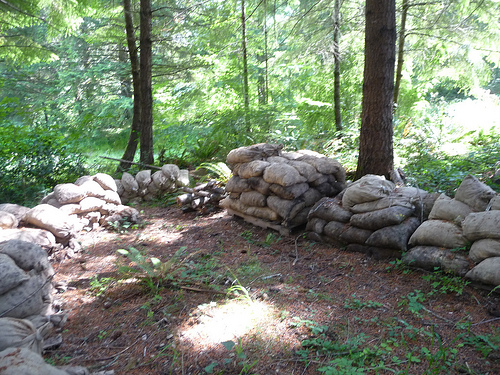 [Using bags of waste and injected mycelium, you place upstream from industrial waste zones to bio-filtrate pollutants]
[Using bags of waste and injected mycelium, you place upstream from industrial waste zones to bio-filtrate pollutants]
Another fascinating creation of Stamets, in relation to ecological restoration, is the "Life Box." With combination of mycelium, soil, water, mycorrhizal spores, and tree seeds, all contained in a cardboard box, the hope is that old growth forests can be regenerated across the world, while also putting cardboard to good use.
 [The Life Box]
[The Life Box]
Stamets envisions a future interactive zip code system using google earth to track carbon being sequestered by the dispersal of the Life Box, a way to visually track it's success and activate communal involvement. It can also be used for vegetables, as he as done with a delivery system for places like Darfur, a sort of springloaded garden kit for utilization in disaster stuck areas.
Mycelium's use in pest control in and energy are discussed in greater detail in his TED video, but my main interest is it's proven success in soil building and bio-remediation, a topic I'm sure that we'll continue to discuss here at DUS.
Would Her Perfection Withstand the Provocation of Nature?
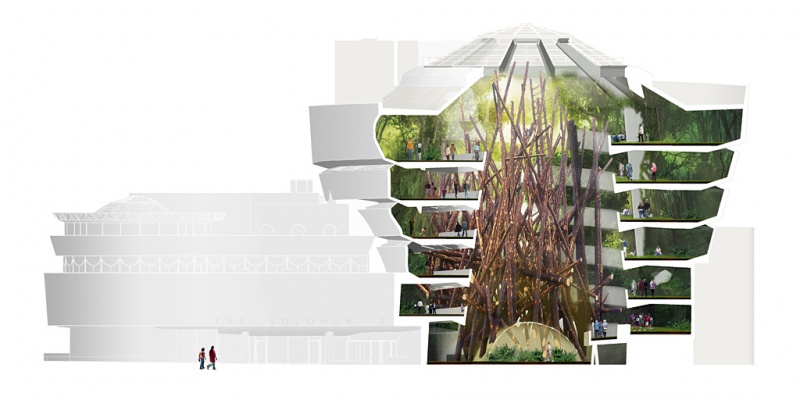 [Forested Guggenheim. Image via West 8]
[Forested Guggenheim. Image via West 8]
I find that there are few Landscape Architecture studios practicing on the cusp of boundries. So, those that are advancing and changing the profession (or at least in my humble opinion) I try to shed light on them here at DUS. West 8, is an office few would argue as a beacon for LA's to seek the extraordinary.
A new conceptual projects addresses Frank Lloyd Wright's Guggenheim, asking: "Would her perfection withstand the provocation of nature?" From West 8's site:
Since its opening in 1959, the Frank Lloyd Wright–designed Guggenheim building has served as an inspiration for invention, challenging artists and architects to react to its eccentric, organic design. The central void of the rotunda has elicited many unique responses over the years, which have been manifested in both site-specific solo shows and memorable exhibition designs. For the building’s 50th anniversary, the Guggenheim Museum invited West 8 and a variety of artists, architects, and designers to imagine their dream interventions in the space for the exhibition.
West 8's submittal is based on the assertion that Frank Lloyd Wright’s Guggenheim Museum is the ultimate prototype of the sublime in modern architecture. Genuinely iconic, it is a harmonious resolution of material, geometry and space with performance and context. When completed it immediately became sterile, victimized by its own perfection: a sacred virgin in perpetuity. Would her perfection withstand the provocation of nature? Or is this perfection derived from her dialogue with the neutral Manhattan grid?
It is inevitable that the building should be confronted with the raw, chaotic vitality of nature. Will she keep her beauty, enhancing visitor’s experiences? This can be tested by importing a forest, a 1:1 scale mockup, consisting of two key elements: a mossy fern meadow stretching from the base to the top of the rotunda - a linear interior park, and 100 upended logs the height of the atrium. Visitors may respond appreciatively to light qualities, lovely fragrances and tactilities, or they may be critical: ‘Were the logs sustainably harvested? Will plants do well in such an environment?’ Until now, it appears that maximum adaptation has been be defined by curators’ efforts to minimize the impact of installations. Will the Guggenheim remain a sleeping beauty in a glass box, where nature cannot touch her?
'Contemplating the Void: Interventions in the Guggenheim Museum' was organized by Nancy Spector, Chief Curator, and David van der Leer, Assistant Curator for Architecture and Design. The exhibition will feature renderings of these visionary projects in a salon-style installation that will emphasize the rich and diverse range of the proposals received. Contemplating the Void: Interventions in the Guggenheim Museum will be on view at the Solomon R. Guggenheim Museum from February 12 to April 28, 2010.

